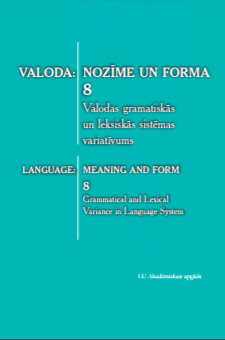Atrašanās vietas un darbības virziena izteikšana latviešu, lībiešu un igauņu valodā
Encoding of location and direction of motion in Latvian, Livonian and Estonian
Author(s): Valts ErnštreitsSubject(s): Language studies, Baltic Languages
Published by: Latvijas Universitātes Akadēmiskais apgāds
Keywords: adposition; direction of activity; locative; spatial attitudes; spot positions;
Summary/Abstract: This paper studies one of the notions of spatial relations, i.e. the direction of motion as a change of location, and its coding in Latvian, Livonian and Estonian. More specifically, it looks into the indication of movement towards, to or into something. Estonian and Livonian (Finnic languages) have quite a large number of cases that indicate different states of location, including the denoting of direction, nevertheless adpositions (postpositions) can be used as well to code different spatial relations. As other Indo-European languages, Latvian commonly uses prepositions to denote the direction. Direction and motion to a location could also be expressed by the Locative case in Latvian. In this comparative study we examine instances of the use of adpositions or cases and the conditions for variating between them. We look at factors that influence the expression of direction in order to study which factors influence the choice between adpositions and cases, or the alternative usage of both, which is also sometimes possible. The comparison of three geographically closely situated languages allows us to see similarities and differences in choosing between adposition and cases, and to look for parameters determining their use. The data used for the paper has mostly been taken from the examples given in the “Livonian-Estonian-Latvian dictionary” (2013) and “Estonian-Latvian dictionary” (2015).
Journal: Valoda: nozīme un forma
- Issue Year: 2017
- Issue No: 8
- Page Range: 152-166
- Page Count: 15
- Language: Latvian

